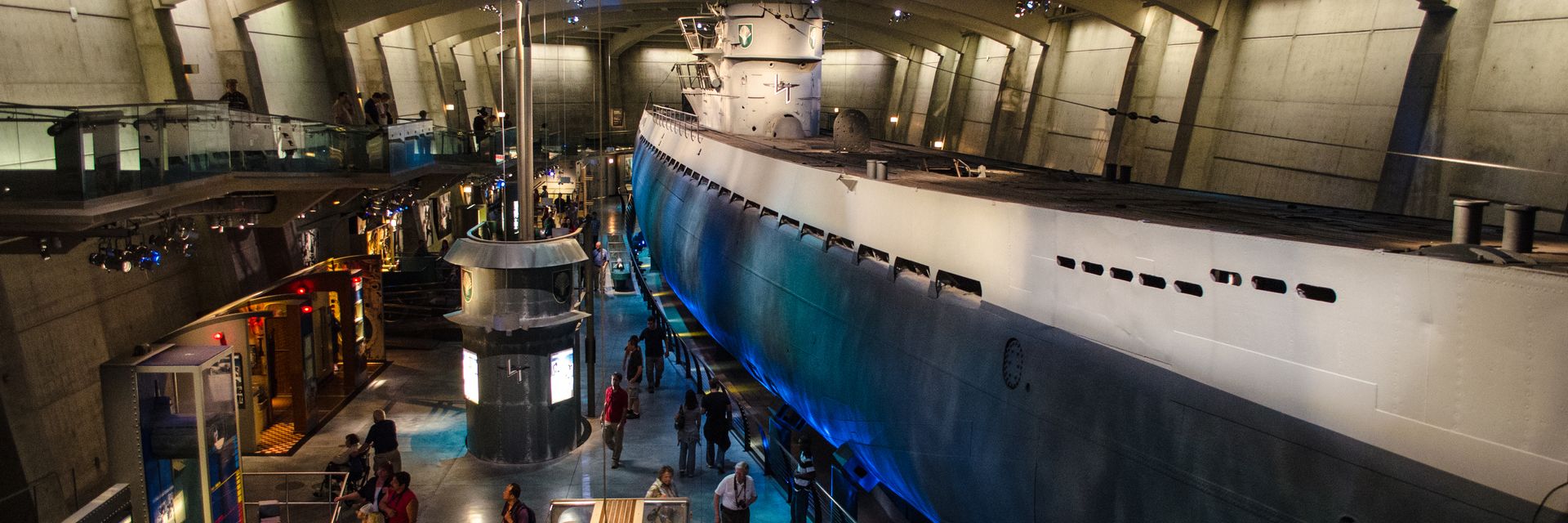Capturing the German U-boat intact (with its Enigma machine) was hard; rolling it in one piece across 800 yards of Chicago real estate ten years later was harder.
◊
When I was a boy, a highlight of every summer was visiting family in Chicago. And one highlight of each visit was a trip to the Museum of Science and Industry to make my way through the tight confines of a real-life Nazi submarine, the U–505.
Taken on the high seas off Africa in 1944, the U-505 was the first enemy vessel captured whole and brought to port by the U.S. Navy since the War of 1812. I was more interested, however, in the boat’s details – bunks hung directly above torpedoes, for example – than how it ended up in the museum’s back yard.
But the U-505’s story is as gripping as any tale to come out of World War II, part of a little-remembered aspect of a world at war in which the entire Atlantic Ocean, from North America to Africa, Greenland to Brazil, was a battleground where the eventual Allied victory in Europe was decided.
Watch Submarines: The Invisible Weapon on Magellan TV:
https://www.magellantv.com/video/submarines-the-invisible-weapon
U-boats Attack Britain’s U.S. Lifeline
After war was declared in 1939, Great Britain had to import raw materials for the vast majority of its manufactured products and many consumer goods. It was estimated that the nation needed one million tons of supplies every week to sustain its fight against Nazi Germany. The U.S. was quick to offer Britain a lifeline of cargo ship convoys. Germany, as it did during World War I, sent a fleet of U-boats to destroy them.
Contrary to popular belief, U-boats were not deep-diving stealth weapons. They were instead fast, highly maneuverable surface craft designed to submerge for relatively brief periods (8 to 12 hours) at fairly shallow depths.
Once America entered the conflict, U-boats roamed just off the East Coast and into the Gulf of Mexico. To trap convoys guarded by warships, German subs operated in a north/south picket line across the mid-Atlantic shipping lanes. When one spotted a convoy it radioed coded messages to others close by that would then gather in a so-called Wolfpack. Some engaged battleships, while others torpedoed cargo vessels. Through 1941, the losses in such attacks were staggering.
But that year, two developments helped change the equation in Britain’s favor. The first was a new kind of depth charge. Smaller, lighter, and launched in circular clusters, it was more effective in disabling a target. A successful use of the new weapon allowed British sailors to board an incapacitated U-boat before it sank off Greenland. They recovered several cipher books and an Enigma machine, the crucial top-secret device used by the German military to code, and decode, messages.
The Enigma’s capture was equal to the Manhattan Project to build the atomic bomb as the greatest secret of the war. The German high command never suspected it had fallen into Allied hands and continued to use the system, albeit with greater levels of complexity that occasionally hampered code breaking, until the end of the war.
In fact, it was by way of a decoded Enigma message that the U-505 ended up in Chicago.
A Navy Captain Plans to Grab a Top Secret Prize
In the spring of 1944, Chicago native Capt. Daniel Gallery commanded a sub-hunting task force of five destroyers in the South Atlantic. That April, Gallery’s group sank a U-boat, but not before a ship pulled alongside the stricken vessel to rescue its sailors who had opened valves to the sea and set timed detonators to scuttle the vessel. Gallery realized that, with proper knowledge and training, a U.S. boarding party might take a Nazi sub relatively intact.
Thanks to intercepted Enigma messages, the Americans were able to determine general U-boat positions, but exact locations were radioed using a second-generation Enigma machine not in Allied possession. This was the prize Capt. Gallery set out to claim.
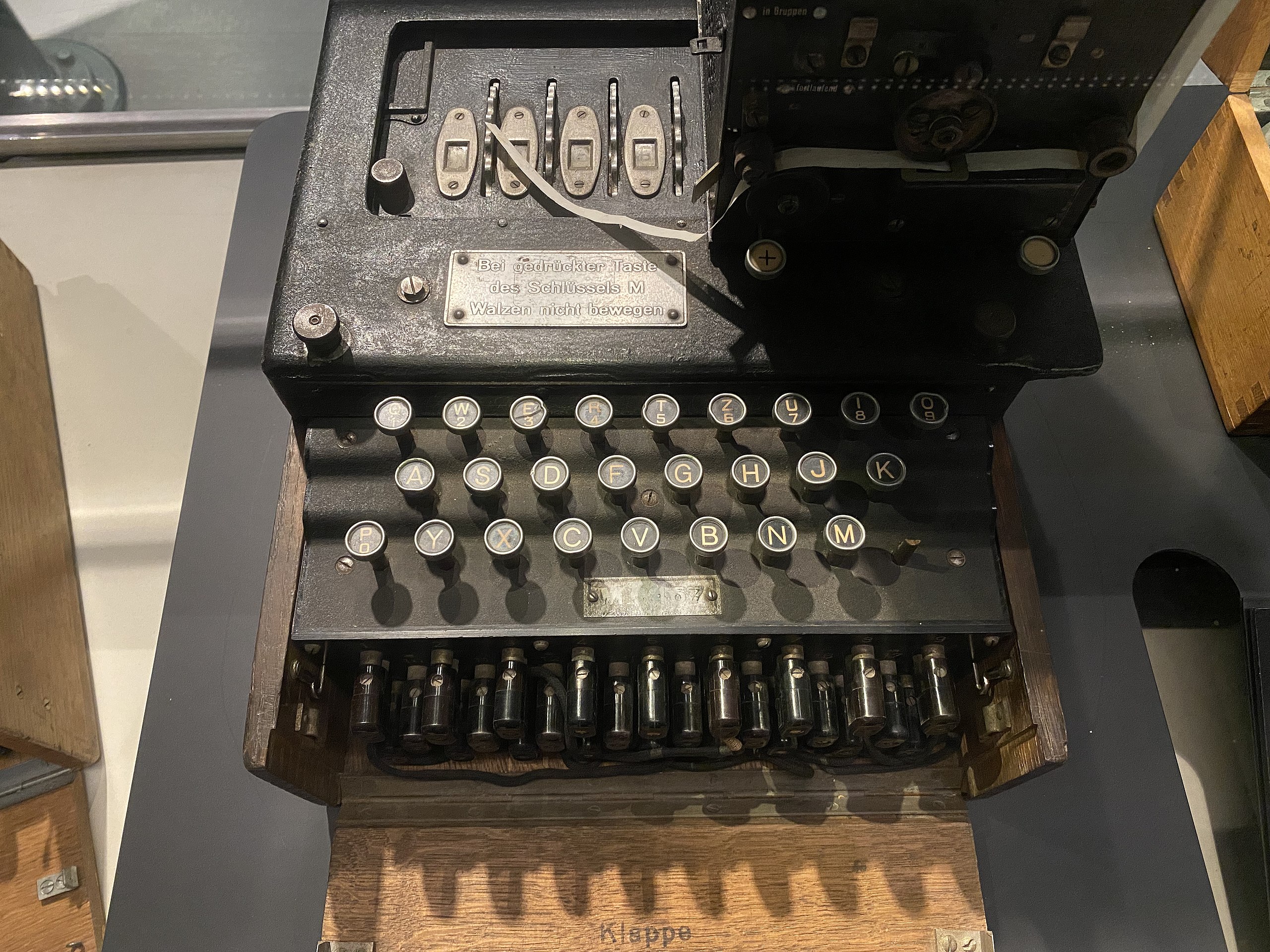
The Enigma machine taken when the U-505 was captured (Credit: Arnold Reinhold, via Wikimedia Commons)
Using information provided by the rescued German sailors, Gallery ordered the training of two boarding parties to send should opportunity arise. The first would grab an Enigma machine and any related documents. That done, the second team would close any sea valves and disarm any explosives. Now, all they needed was a U-boat.
On June 4, decoded messages alerted Gallery’s group that the U-505 was close by. When a spotter plane from the aircraft carrier Guadalcanal found it running on the surface a few miles from the task force, battle was joined. The Germans fired a torpedo (that missed) before a circle of small depth charges exploded around it. Heavier depth charges cracked the hull of the stunned U-boat, forcing it to surface and its crew to abandon ship.
U.S. Seamen Salvage a Sinking Sub
With the 58-man German crew in custody, Capt. Gallery’s first boarding party secured two Enigma machines and some 900 lbs of related documents. The second team had the far less enviable task of boarding a sinking ship, now 95 percent underwater (though still slowly moving under power in a wide circle), likely set to explode at any moment.
Luckily, the Germans had been so certain that the boat was sinking that they did not arm the scuttling explosives. Once the open sea valves were shut, the Americans had to find a way to shut off the engines and turn on the bilge pumps to take the U-505 in tow. Again luck intervened.
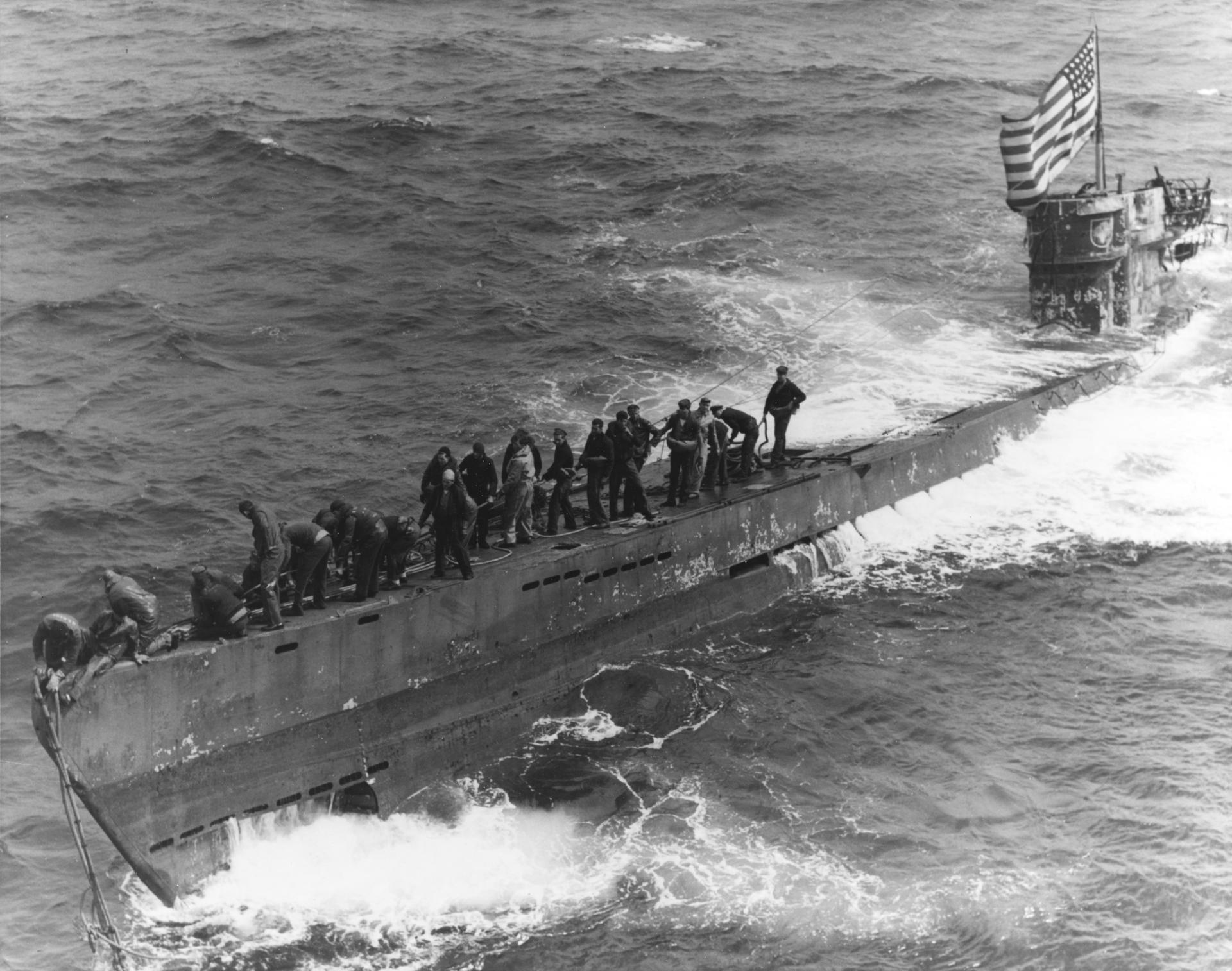
U.S. sailors work to attach a tow line to the prow of the U-505 (Credit: U.S. Navy/National Archives)
A Polish member of the U-boat’s crew was induced, with the promise of a better life in America after the war, to explain to a Polish-speaking U.S. sailor how the engines and bilge pumps operated. Armed with this information, a boarding party of machinists took most of a night working in a flooded, oily labyrinth of pipes, cables, and gangways, to secure and fully surface the vessel. A Navy tugboat arrived to take the U-505, now flying an American flag from its tower, some 1,700 nautical miles to Port Royal, Bermuda. Once there, it was quickly painted to disguise it as a U.S. submarine.
A furious U.S. Chief of Naval Operations, Adm. Ernest King, at first wanted to court martial Capt. Gallery for not sinking the boat, thinking that if the Germans learned of the capture, they would change the Enigma codes ahead of the D-Day landings. Once Adm. King cooled off, Capt. Gallery was promoted to command an aircraft carrier, and his task force received a Presidential Unit Citation for nabbing the U-505 and its top-secret prizes. Along with the Enigma machine, the sub was equipped with state-of-the-art acoustic-targeted torpedoes, a type that the Americans had not seen before.
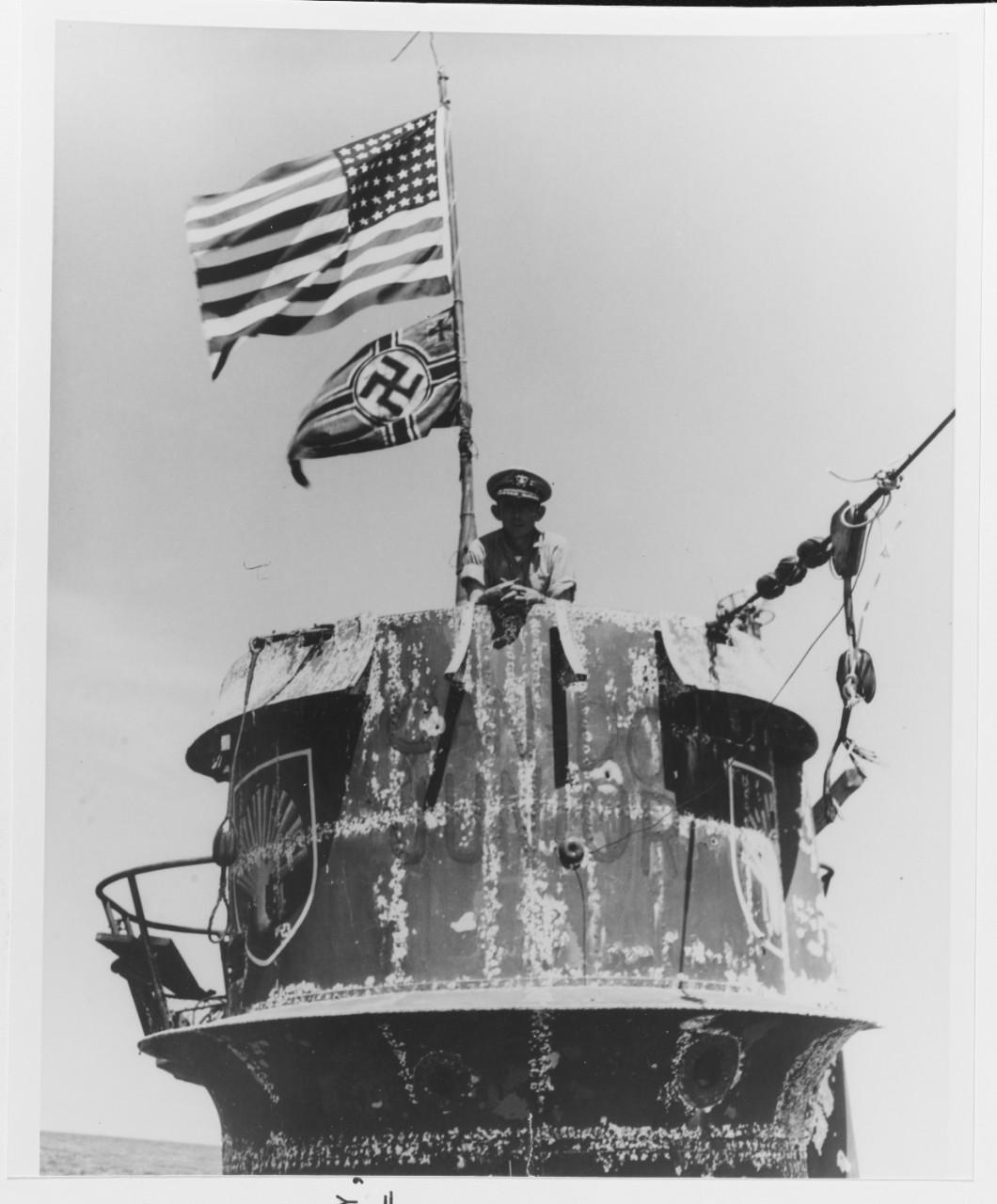
Capt. Daniel Gallery, USN, on the conning tower of the U-505 (Credit: U.S. Navy/National Archives)
With the end of the war in Europe, the U-505’s secrecy became moot. The Navy revealed details of its capture in May 1945. The boat was towed to several East Coast cities as part of the last drive to sell war bonds before the Japanese surrender that August.
In dry dock for years after the war, the Navy picked the U-505 clean of all movable parts, especially its periscope, for study. By the early ’50s, the plan was to tow what remained out to sea to use for target practice. But Capt. Gallery’s brother John, a prominent Chicago priest and former Navy chaplain, had a better idea.
A Museum Rescues the U-505 One More Time
In one more stroke of good fortune for preservationists, Chicago’s Museum of Science and Industry had been asking the Navy for a submarine to display for nearly 20 years. Father Gallery, a friend of the museum’s director, and his brother, now a rear admiral, convinced Chicago’s City Council to formally request the Navy to donate the U-505. The Navy agreed, though it would not allocate any funds for the boat’s transportation to the Windy City from its dock in Portsmouth, New Hampshire.
The Gallery brothers led a campaign that raised the $250,000 cost of transport (nearly $2,500,000 today). Towed through the St. Lawrence Seaway, and stopping at several Great Lakes ports along the way, it arrived on Chicago’s southern shoreline in June 1954. However, the 3,000 miles from Portsmouth was the easy part compared to the 800 feet of dry land it had to cross to reach its new museum home.
Nearly the length of a city block, and weighing some 850 tons, the U-505 was nestled in a floating dry dock where a steel frame was built around its hull. In mid August, the dock was maneuvered to a railed ramp. The frame holding the boat was then jacked up over four feet and steel rollers set underneath. In early September the U-boat was pulled over the rails to its new home at a steady clip of 40 feet per hour.
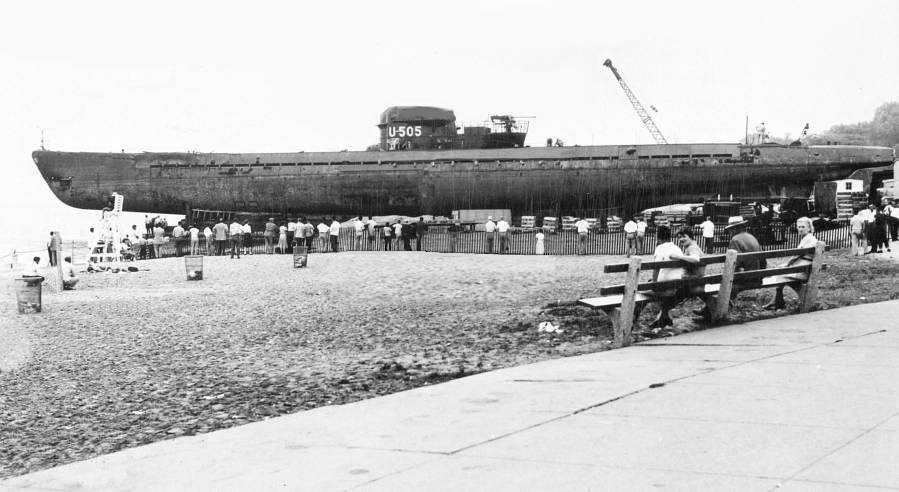
The U-505 crosses the Lake Michigan shoreline on its way to Chicago’s Museum of Science and Industry in September 1954. (Source: Public Domain, via connectingthewindycity.com)
Settled onto its stand and refurbished with parts sent from Germany, the restored U-505 drew nearly eight million visitors, yours truly among them, in its first decade on display. But after 40 Chicago winters, the boat, designed for a nautical lifetime of five years, had deteriorated to a nearly unsafe degree. In 1997, the museum undertook an engineering project to preserve the U-505 that dwarfed the effort of towing it out of Lake Michigan. The plan was to house it in a new gallery, 42 feet underground.
One of the U-505’s mechanics, Hans Goebeler, emigrated to Chicago after he retired and regularly visited the installation to give impromptu talks about life on board. Between 1954 and 2004, the museum held seven reunions for the surviving German crew and their American counterparts.
A two-year conservation effort strengthened the hull and repainted it and the interior in historically accurate shades of blue, gray, and white. Worn parts were replaced with ones recreated from original plans. Finally, the hull was further reinforced to aid in its final journey to the underground gallery that had been excavated over 300 yards away.
Taking almost a week, 18 hydraulic dollies, each with eight enormous tires, rolled the boat to the edge of its new 75 x 300-foot underground pen. There it was nudged on Teflon pads across four steel beams supported by jacks that, over the course of two days, lowered the U-505 to its ultimate resting place. Roofed over, the climate-controlled gallery is on the National Registry of Historic Places, a memorial to the tens of thousands who perished during the Battle of the Atlantic.
In retrospect, the U-505’s remarkable story is a small antidote to the disasters of the Second World War. At a time when people died by the hundreds in sea battles, only one German sailor was killed in the capture of the U-505. Instead of the regular fate of enemy vessels, the boat was saved through foresight, good luck, and the prompt, heroic action of common sailors. After the war, the U-505 was saved again by preservationists and educators – and a great civic institution’s willingness to spend millions of dollars on two extraordinary feats of industrial engineering – to give it a permanent home.
Today the U-505 is not only a memorial to valor and sacrifice; it’s a monument to human ingenuity and, after the terrible ruin of war, to the guiding spirits of reconciliation and care.
Ω
Contributing writer Joe Gioia edited and wrote for several long-gone photography magazines. He is the author of The Guitar and the New World, a history of American roots music, and lives in Livingston, Montana.
Title Image: The U-505 in its underground gallery at Chicago’s Museum of Science and Industry (Credit: Raymond Tambunan/Wikipedia)
